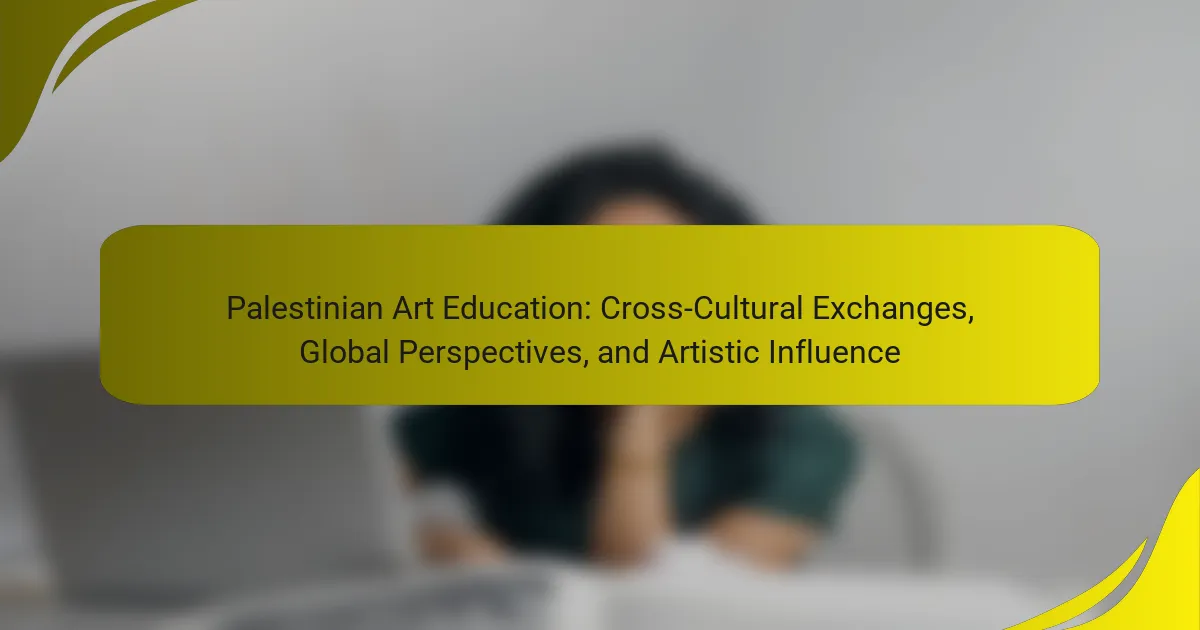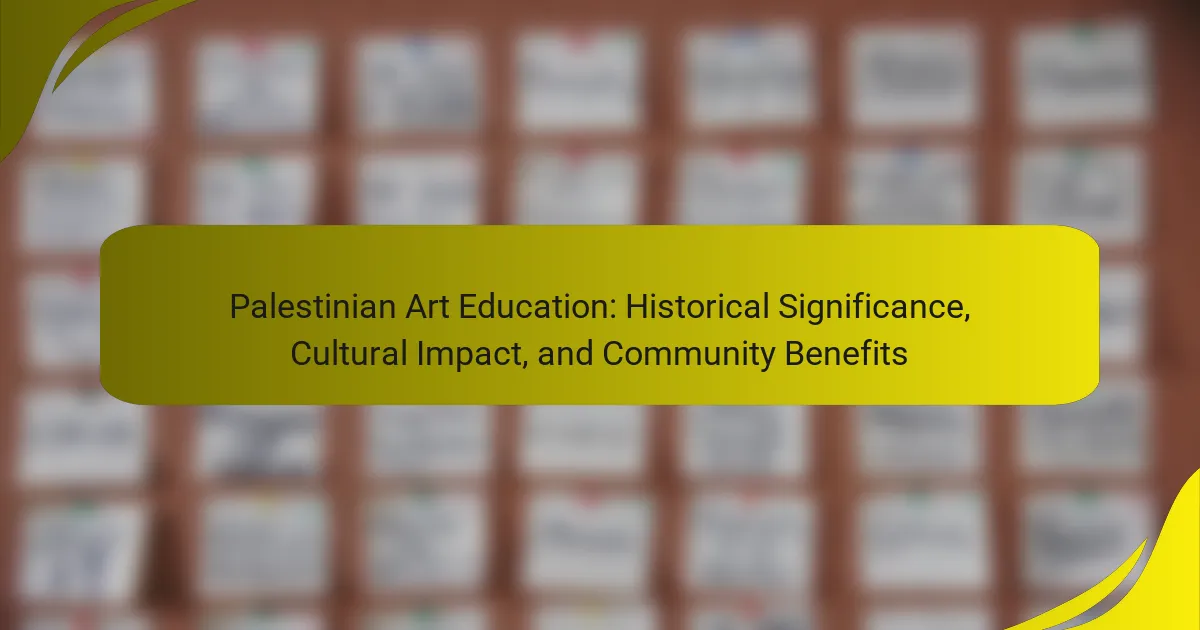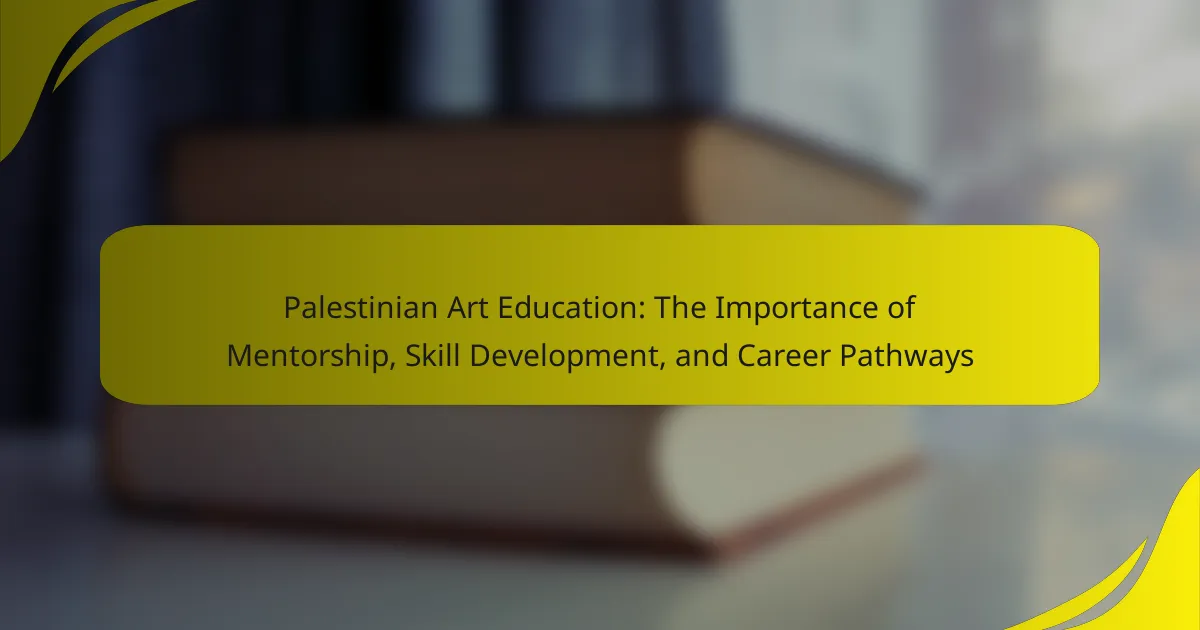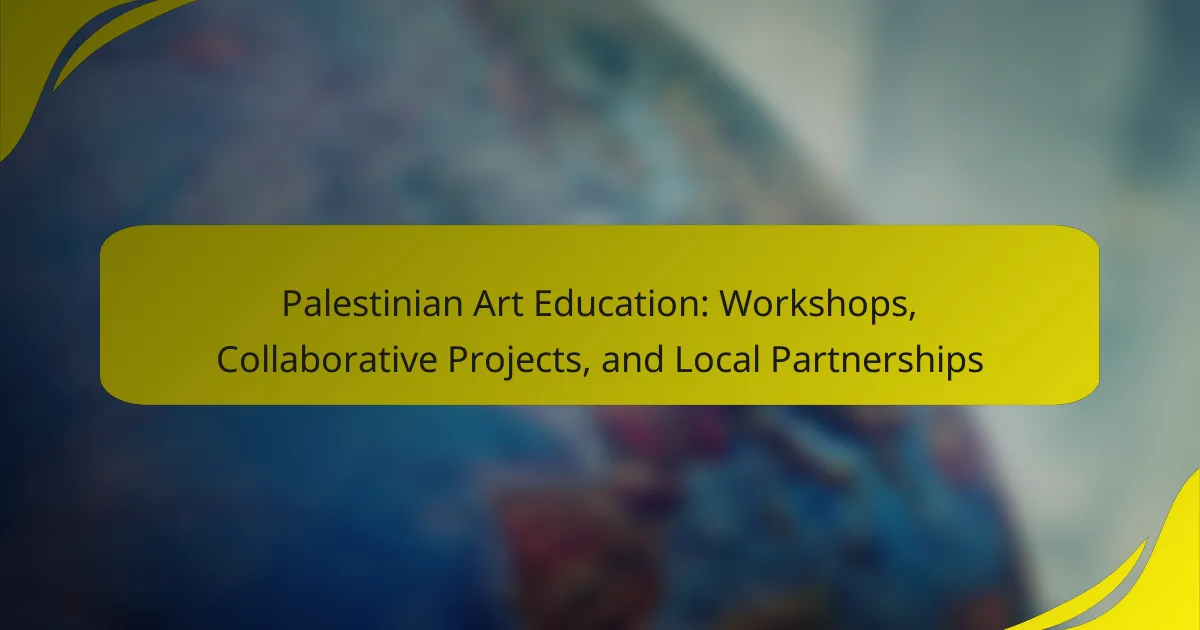Palestinian art education is essential for preserving cultural heritage and fostering identity within the Palestinian community. It serves as a platform for transmitting traditional values and narratives through various artistic expressions, including painting, sculpture, and digital media. This educational approach enhances creativity, critical thinking, and problem-solving skills among students while promoting community engagement through collaborative projects. The integration of contemporary themes with traditional techniques enriches cultural dialogue and strengthens personal and collective empowerment. Future prospects for Palestinian art education include increased access to digital platforms, collaborative initiatives with international artists, and support for local art programs, indicating a potential for growth and innovation in this vital field.
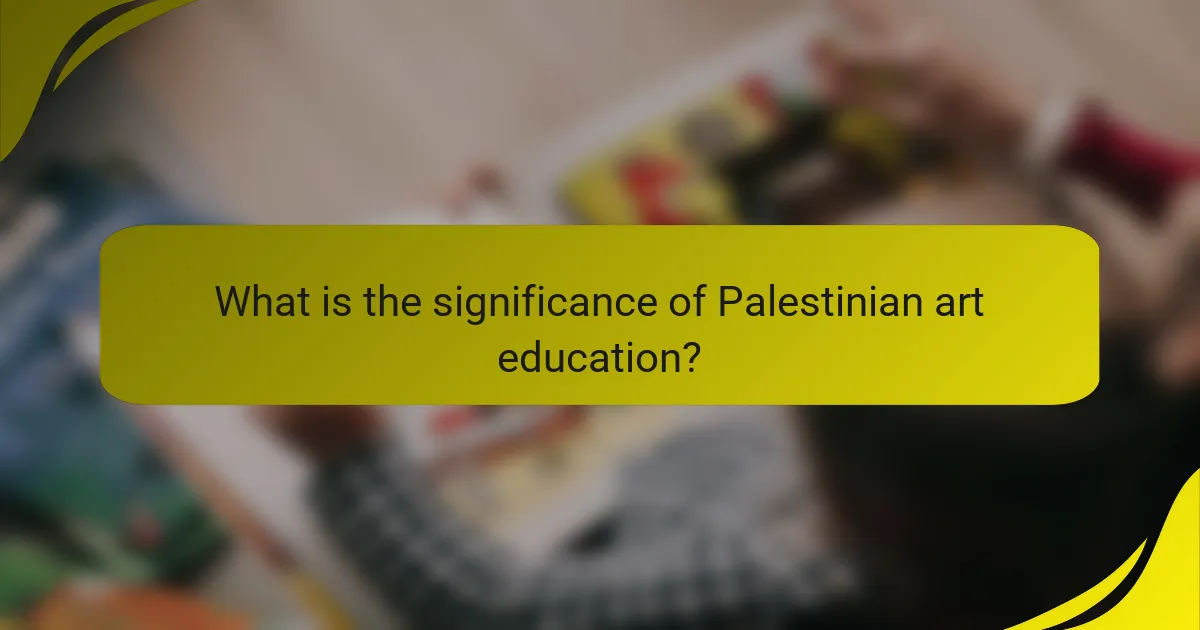
What is the significance of Palestinian art education?
Palestinian art education is significant for preserving cultural heritage and fostering identity. It plays a crucial role in transmitting traditional values and narratives through artistic expression. Art education empowers individuals to explore their cultural roots and articulate their experiences. This educational approach cultivates creativity and critical thinking skills among students. Moreover, it promotes community engagement and social cohesion through collaborative art projects. Historical context shows that art has been a form of resistance and resilience in Palestinian society. By integrating contemporary themes with traditional forms, art education enriches the cultural dialogue. Overall, it serves as a vital tool for personal and collective empowerment within the Palestinian community.
How does Palestinian art education contribute to cultural preservation?
Palestinian art education contributes to cultural preservation by teaching traditional artistic practices and cultural narratives. It enables students to learn about their heritage through various forms of art, including painting, sculpture, and textile work. This education fosters a sense of identity and belonging among young Palestinians. By engaging with their history, students can express cultural values and beliefs. Art education also promotes the continuation of folk traditions and crafts that are at risk of fading. Schools and community programs often include workshops led by local artists. These initiatives help to maintain the relevance of cultural expressions in contemporary society. Overall, Palestinian art education serves as a vital tool for sustaining cultural heritage.
What historical contexts influence Palestinian art education?
Palestinian art education is influenced by historical contexts such as colonialism, conflict, and cultural heritage. The British mandate from 1920 to 1948 led to significant changes in educational structures. The 1948 Nakba resulted in a loss of land and displacement, impacting cultural expression. Subsequent conflicts, including the 1967 war, further shaped artistic narratives. The Oslo Accords in the 1990s introduced new dynamics in education and cultural policy. Palestinian artists often draw from their history of resistance and resilience. Educational institutions emphasize traditional forms and contemporary expressions. These contexts create a unique framework for understanding and teaching art in Palestine.
How does art education reflect the Palestinian heritage?
Art education reflects Palestinian heritage through the incorporation of traditional themes and cultural narratives. It emphasizes the historical and social context of Palestinian identity. Students learn to express their experiences and struggles through various art forms. This process fosters a sense of belonging and continuity with their past. Art education also promotes the use of indigenous materials and techniques. It encourages the exploration of folklore, music, and literature within artistic expression. By engaging with these elements, students preserve and celebrate their cultural legacy. This educational approach strengthens community ties and raises awareness of Palestinian history and identity.
In what ways does Palestinian art education help in building identity?
Palestinian art education helps in building identity by fostering cultural expression and historical awareness. It encourages students to explore their heritage through various artistic mediums. This exploration cultivates a sense of belonging and pride in their cultural roots. Art education also highlights the narratives and experiences unique to the Palestinian identity. Through workshops and community projects, students engage with traditional art forms. This engagement reinforces their connection to their history and community. Furthermore, art serves as a powerful tool for social commentary and activism. It allows students to express their perspectives on contemporary issues affecting their identity. Overall, Palestinian art education plays a crucial role in shaping and affirming individual and collective identities.
What role does art play in shaping Palestinian national identity?
Art plays a crucial role in shaping Palestinian national identity. It serves as a medium for expressing cultural heritage and collective experiences. Through various forms, such as painting, music, and literature, artists convey narratives of resistance and resilience. These artistic expressions foster a sense of belonging among Palestinians. They also highlight historical struggles and aspirations for self-determination. Art becomes a tool for preserving cultural memory in the face of adversity. Notable examples include the works of artists like Ismail Shammout and Sliman Mansour. Their art reflects the Palestinian experience and contributes to national consciousness. Overall, art is integral to the ongoing dialogue about identity and heritage in Palestine.
How do artists express their identity through educational practices?
Artists express their identity through educational practices by integrating cultural narratives into their work. They utilize traditional techniques to convey personal and communal histories. This approach helps preserve heritage while fostering a sense of belonging. For instance, Palestinian artists often incorporate local materials and motifs in their art. This practice not only showcases their identity but also educates others about their culture. Educational settings enable artists to share these narratives with students and communities. Workshops and collaborative projects further enhance this exchange of identity and culture. This method of expression reinforces the collective memory and resilience of their communities.
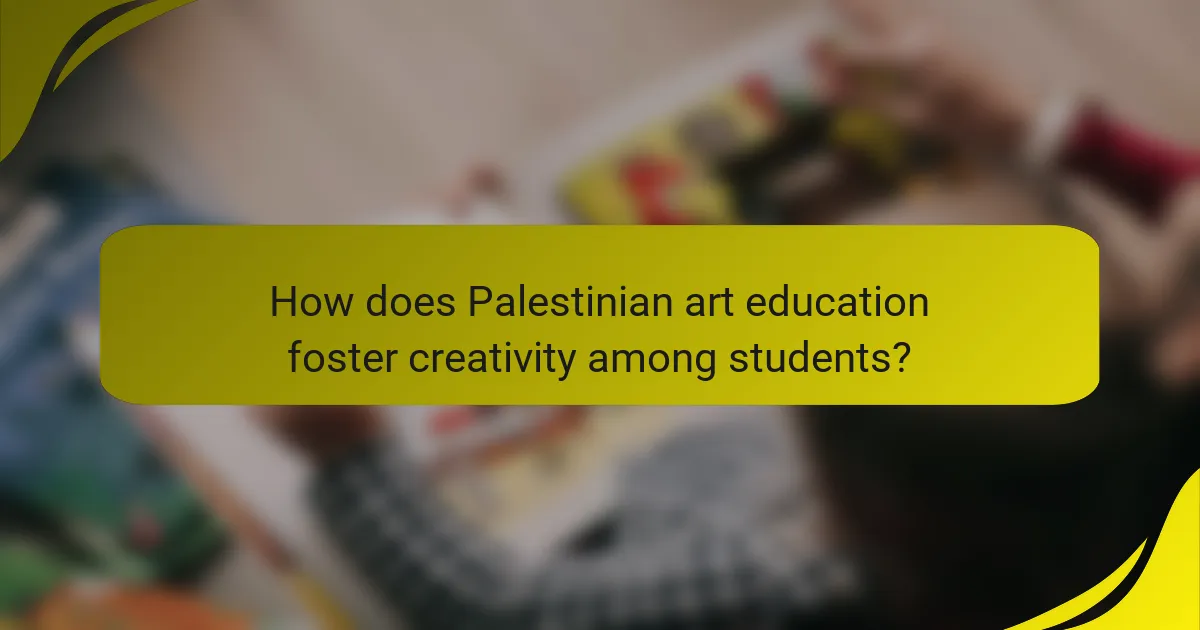
How does Palestinian art education foster creativity among students?
Palestinian art education fosters creativity among students by encouraging self-expression and cultural exploration. It integrates traditional techniques with contemporary practices. Students engage in various art forms, including painting, sculpture, and digital media. This diversity allows them to experiment and innovate. Art education also emphasizes the importance of storytelling through visual means. This approach helps students connect with their heritage and identity. Research shows that art education enhances critical thinking and problem-solving skills. According to a study by the National Endowment for the Arts, students involved in arts education perform better academically. Thus, Palestinian art education plays a crucial role in developing creative capacities in students.
What methodologies are used in Palestinian art education to encourage creativity?
Palestinian art education employs various methodologies to encourage creativity. These methodologies include experiential learning, which allows students to engage directly with their environment. Collaborative projects foster teamwork and collective creativity among students. Additionally, critical reflection is encouraged, helping students analyze their work and the work of others. Culturally relevant content is integrated into the curriculum, connecting art to Palestinian identity and heritage. Workshops and community involvement provide practical experience and exposure to diverse artistic practices. These approaches collectively enhance creative expression and artistic skills among students.
How do these methodologies differ from traditional art education approaches?
These methodologies emphasize experiential learning over rote memorization. Traditional art education often focuses on technical skills and historical art movements. In contrast, these methodologies prioritize cultural context and personal expression. They encourage students to engage with their heritage through artistic practices. This approach fosters a deeper connection to identity. Traditional methods may lack this cultural integration. Additionally, these methodologies often promote collaboration among students. This contrasts with the individualistic focus found in traditional art education. Overall, the methodologies provide a more holistic and culturally relevant framework for art education.
What are the outcomes of fostering creativity in students?
Fostering creativity in students leads to enhanced problem-solving skills and improved academic performance. Creative students demonstrate greater adaptability in various situations. They are often more engaged in learning activities. Creativity encourages critical thinking and innovation. Studies show that creative students perform better in collaborative tasks. This enhances their ability to work in teams. Furthermore, fostering creativity can improve emotional well-being. Creative expression allows students to process their feelings effectively. Overall, fostering creativity contributes to holistic student development and prepares them for future challenges.
What challenges does Palestinian art education face?
Palestinian art education faces significant challenges due to political instability and limited resources. The ongoing conflict restricts access to educational facilities and materials. Many art teachers lack formal training and professional development opportunities. Additionally, cultural censorship impacts the expression of artistic ideas. Economic hardships affect students’ ability to pursue art as a career. The fragmentation of Palestinian territories complicates collaboration among art institutions. These factors hinder the growth and development of a robust art education system in Palestine.
How do socio-political factors impact art education in Palestine?
Socio-political factors significantly impact art education in Palestine. The ongoing conflict and occupation create challenges for educational institutions. Limited resources and funding hinder the development of comprehensive art programs. Restrictions on movement affect access to art supplies and exposure to diverse artistic influences. Furthermore, political narratives can influence the curriculum, often prioritizing national identity over artistic expression. According to a report by UNESCO, these conditions result in a lack of formal training opportunities for aspiring artists. Consequently, many students face barriers in pursuing art as a viable career. The socio-political landscape shapes not only the availability of art education but also its content and purpose in Palestinian society.
What resources are lacking for effective art education in Palestinian communities?
Palestinian communities lack essential resources for effective art education. These resources include sufficient funding for art programs. Limited access to quality art materials hampers creative expression. Additionally, there is a shortage of trained art educators. Many schools lack dedicated art spaces or studios. Cultural institutions often do not provide adequate support. Furthermore, there is minimal access to art history and theory education. These deficiencies impact students’ ability to engage in meaningful artistic practices.
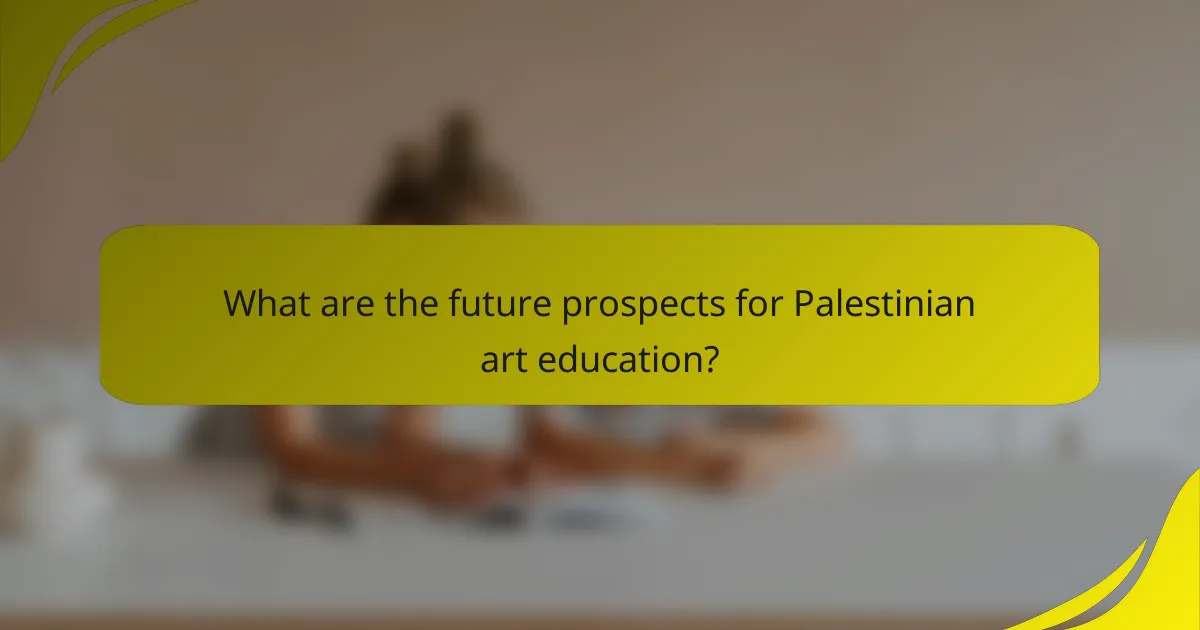
What are the future prospects for Palestinian art education?
The future prospects for Palestinian art education are promising yet challenging. Increased access to digital platforms can enhance learning opportunities for students. Collaborative projects with international artists may foster cultural exchange. Local initiatives are emerging to integrate traditional art forms into curricula. Investment in community art programs can strengthen local engagement. Government support for educational institutions is crucial for sustainability. Global interest in Palestinian culture may attract funding and resources. These factors collectively indicate a potential for growth and innovation in Palestinian art education.
How can technology enhance Palestinian art education?
Technology can enhance Palestinian art education by providing access to digital tools and resources. These tools can facilitate online learning and collaboration among students and teachers. Virtual platforms can host art classes, workshops, and exhibitions, allowing broader participation. Digital art software enables students to experiment with techniques and styles that may not be available locally. Additionally, technology can connect Palestinian artists with global audiences, promoting cultural exchange. Furthermore, online archives and databases can preserve and showcase Palestinian art history. This access can inspire new generations of artists to engage with their heritage creatively.
What digital tools are being integrated into art education programs?
Digital tools integrated into art education programs include software like Adobe Creative Suite, Sketchbook, and Procreate. These tools enhance creativity and technical skills. Virtual reality (VR) platforms are also being used to create immersive learning experiences. Online collaboration tools like Google Workspace facilitate group projects and feedback. Additionally, digital portfolios allow students to showcase their work effectively. Research indicates that these tools improve engagement and learning outcomes in art education. For instance, a study by the National Art Education Association highlighted the positive impact of digital tools on student creativity and expression.
How does online education expand access to art education in Palestine?
Online education expands access to art education in Palestine by removing geographical barriers. It allows students in remote areas to participate in art courses that were previously unavailable. Online platforms provide a variety of resources, including video tutorials and virtual workshops. This accessibility fosters creativity among students who may lack traditional art education facilities. Additionally, online education can connect Palestinian artists with global instructors and experts. This interaction enhances the quality of learning and exposure to diverse artistic styles. The flexibility of online courses accommodates students’ varying schedules, encouraging more participation. Overall, online education democratizes art education in Palestine, making it more inclusive and widespread.
What best practices can be implemented in Palestinian art education?
Integrating community engagement in Palestinian art education enhances cultural relevance. Collaborative projects with local artists can provide real-world context. Incorporating traditional techniques preserves heritage and fosters identity. Curriculum development should include contemporary issues affecting Palestinian society. Providing access to diverse art forms encourages creativity and expression. Training teachers in inclusive practices ensures all voices are represented. Utilizing technology can broaden access to resources and global art perspectives. Establishing partnerships with cultural institutions can provide additional support and resources.
How can collaboration with international art institutions benefit local education?
Collaboration with international art institutions can enhance local education by providing access to diverse artistic perspectives and methodologies. This exposure enriches the curriculum and fosters creativity among students. International partnerships often facilitate workshops led by renowned artists. These workshops can introduce innovative techniques and concepts not commonly found in local settings. Additionally, such collaborations can lead to student exchanges, allowing learners to experience different cultures and art forms firsthand. Research indicates that exposure to global art practices can improve critical thinking skills. Furthermore, these partnerships can secure funding and resources for local art programs. This financial support can help sustain and expand educational initiatives. Overall, collaboration can significantly elevate the quality of art education in local contexts.
What community initiatives can support art education in Palestine?
Community initiatives that can support art education in Palestine include local workshops and art programs. These initiatives provide hands-on experiences for students. They often focus on traditional Palestinian art forms. Collaborations with local artists can enhance the learning experience. Community centers can host art exhibitions to showcase student work. Schools can partner with NGOs to provide resources and training. Fundraising events can help secure materials for art classes. Art festivals can promote cultural heritage and community involvement. These initiatives collectively foster creativity and preserve Palestinian identity.
Palestinian art education is a critical entity that plays a significant role in preserving cultural heritage, building identity, and fostering creativity within the Palestinian community. The article explores how art education transmits traditional values, promotes community engagement, and enhances individual expression through various artistic mediums. It examines the historical contexts influencing art education, the methodologies employed to encourage creativity, and the socio-political challenges faced by educators and students. Additionally, the article highlights the potential of technology and community initiatives to enhance art education and preserve Palestinian identity while addressing future prospects for growth and innovation in this field.
